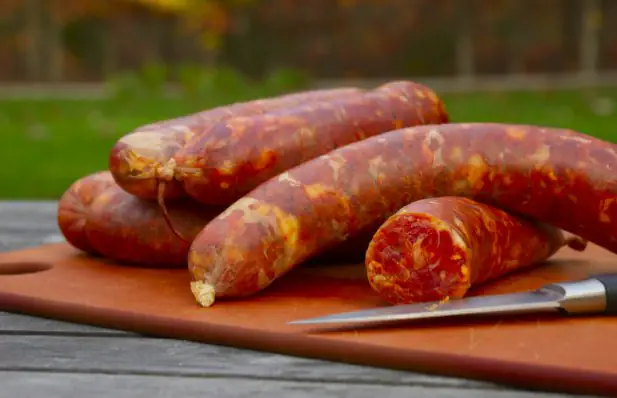Posted on Sunday, April 2, 2017 in
Pork Recipes
Traditional Homemade Chouriço Recipe
This is a delicious and traditional homemade chouriço recipe.
| Preparation time | n/a |
| Cooking Time | n/a |
| Ready In | 10 h 55 min |
| Level of Difficulty | Moderate |
| Servings | 12 |
Ingredients
16 lbs of trimmed and cubed pork butt1/2 cup of garlic cloves, cut in half1/2 cup of salt1 and 1/2 liters of red wine, more if needed100 grams of mild paprika10 grams of black pepper10 grams of ground red hot pepper4 bay leaves15 to 20 hog casings (depending on size)
Get Portuguese ingredients 
Preparation
- Start by trimming most of the fat off the pork.
- Cut pork into cubes, about 2 inch diameter.
- Place all the cubed pork, seasonings and wine in a large basin (try not to break down the bay leaves because they will have to be removed before filling the casting).
- Mix everything together making sure all the seasoning is evenly throughout the pork.
- Cover well with a plastic bag and place meat in fridge (mix every 12 hours for 2 days).
- At every mixing, cook a little bit of the pork to taste if any more seasoning is needed (remember when smoking, the pork will lose a lot of flavor).
- On filling day, rinse each casting a few times, check for hole or defects.
- Using baking twine, tie off one end of the casting.
- Remove all the garlic cloves and bay leaves before filling.
- Place the open end of the casting on the funnel. while holding the casting onto the funnel, begin to fill the casings with the pork, slowly working the meat to the end of the casting (use a safety pin to pop any air pockets)., once filled, tie the other end.
- Hang the filled sausages on a stick or similar without touching, place in the smoker and start your fire.
- Be careful that the flames do not reach the sausage (remember, low heat for a long period of time).
- Keep any eye on the fire for flare ups or if fire goes out.
- After 24 hours, let the fire go out, flip the sausages, then start the firing process over again (at this point when you flip them, you will need to determine if you are halfway done or if it will take longer than an additional 24 hours), this is tricky, and where experience comes into to play, smoking for 24 hours on each side is usually the minimum, (an additional day or two may be needed).
- When the sausages are done, place them indoors and let them dry.
**Place some sort of gate in front of pit opening, so if the fire goes out, animals will come and eat all the hard work you have just put in to it.
Comments


